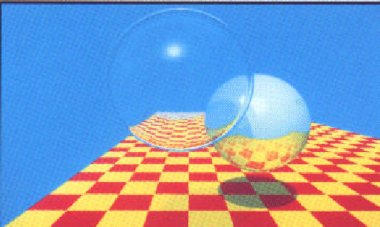Computer Graphics II -- Image
Synthesis
4003 571/4005 769
Winter 2002
Assignment #1
So You Want to Write a Ray
Tracer!
In this first assignment, you
will write a simple ray tracer. In fact, the rey tracer should be suffiently
complex to reproduce the following classic ray traced scene (originally created
by Turner Whitted in his 1984 paper that introduced Ray Tracing to the Computer
Graphics community):

Useful Information
The sets of slides on
ray tracing
and the ray tracing assignment
may be helpful to you.
Ground Rules
The scene to be rendered, as
well as the rendering parameters, will be read from a simple text file (see
Input format
below). The scene will consists of 2 types of objects:
- Spheres -- which will
be specified by it's center and radius. Spheres may be transparent,
and will have a corresponding index of refraction.
- Rectangular chekerboard
floor -- which will be specified by the endpoints of the floor. In
addition the size of the checks will be given. The normal to the floor
will always be in the positive y direction. The floor will not be
transparent.
The scene will consist of a
single point light source, and ambient lighting. Illumination should
be calculated using the Phong Illumination model (Phong parameters for each
object in the scene will be specified in the input file).
Input File Format
All info about the scene, and
all rendering parameters will be specified in a single text file with the
following simple format:
Line 1: Camera Parameters (position (xyz), lookat (xyz), up (xyz), focal
length, image frame size
Line 2: Light Parameters (position, rgb, ambient rgb)
Line 3: Image Resolution and maxdepth
Line 4: Background Color (rgb)
The remaining lines will describe objects in the scene. Each object
description will consists of two lines per object. The type of data
on each of the lines will depend upon the type of object. The first
character on the first line for an object will specify the type of object
being described.
Spheres
1st Line:
S center(x,y,z) radius, index of refraction
2nd Line: ambient color (rgb), diffuse color (rgb), specular color (rgb),
ka, kd, ks, ke, kr, kt
Floor
1st Line:
F vertex1(xyz) vertex2(xyz) vertex3(xyz) vertex4(xyz), cheksize
2nd Line: 1st color: abient (rgb), diffuse (rgb), specular (rgb), 2nd
color ambient (rgb), diffuse (rgb), specular (rgb), ka, kd, ks, kr
Note that floors will not be transparent, this kt will be equal to 0.
A sample input file is available here
. This file describes the image presented above. Click
here
to see the results of running POVRay on this scene description.
Grading: Bells and Whistles
The assignment will be worth
20 points
5 points – for something
that compiles
10 points – for something
that runs incorrectly
15 points – for something
that runs correctly
20 points – something
that runs + extras
For this assignment, the major
"bell and whistle" will be the implementation of transparency (i.e. spawning
the transmission as well as the reflection rays)
Due Dates:
| If
you plan on doing only 1 rendering assignment (#1 or #2) |
Feb 4 |
| If you plan on doing
both rendering assignments (#1 and #2) |
Feb 11 |
Late deliverables will
be penalized 25% for each week late. There is an exception to this
rule: if you forsee any problems with meeting deliverable deadlines, and
see the instructor well in advance (at least one week) of the deadline
that might be missed we can attempt to work out alternate arrangements.
last updated 1/29/03

